The main thing to keep in mind on your Modhera sun temple visit is the heat. As the area is really hot..so best get there in the wee hours. Or plan during the winter, when the season is wonderful. Rainy season can also throw up some really good days… But they can’t be planned.
Mo-dhera basically means a heap of dead bodies.
Yes, you heard it right.
The whole area is some kind of archealogical mine field. With lots of finds including lots of dead bodies in and around this town which then got called Modhera.

Modhera Sun Temple, a full tirtha-kshetra of Old
At the time of its glory this Sun temple was a whole tirthakshetra the guide mentioned – this means it is a complete pilgrimage spot with,
– a powerful temple with the main deity of Sun (one of the 5 major God’s in Hinduism established by Adishankaracharya, Panchayatana Deities – Ganpati, Shiva, Vishnu, Devi, Sun).
– A cremation area which still exists and is being used at the side of the sun temple, though it is cordoned off into a different place from the now-touristy temple premises.
– The river Pushavati which flows nearby, as a bathing / cleansing place. And additionally, the Surya kund which is unmissable right before the Sun temple with its 108 shrines and geometrical stepwell design.
Apart from the main Sun temple, there were smaller shrines to Shiva, Kala Bhairava, Devi and more to the side of the Sun temple structures. One would think these look like newer (humbly made) structures that have been established now, but not so.
The Shiva temple to the side of the grand sun temple, seen in the image to the right, has a humbler and newer structure. But it has been maintained as an actual temple since it was built, so said the Guide. It is not a ruin… I guess when the main Sun temple fell into ruins, some locals still came and lit a lamp at this Shiva shrine? So it would seem.
The base avudaiyar of the Shivalinga in this temple shows carvings of 5 other Shivalingas on it, thus it is called Panchmukhi Shivalinga. This little temple ‘felt’ really nice to me for some reason.
Sun Temple Vastu Carvings
I didn’t understand the outside carvings on the Sun temple very well. The guide we took explained everything, but I was not able to make sense of all of it.
What I did find interesting were some of the prominent carvings on the 3 sides of the main Sun temple – Agni, Yama, Varun, Kubera. The guide said these were all placed as per Vastu shastra…
And there was the Saraswati Devi idol carved right on top of all the other outer wall carvings in a very choice spot. No other idols were that high up, thus signifying her as the major devi for this temple?
The guide said it signified the greatness of Gnana, knowledge. Saraswati is embodying Gnana, Knowledge, Sattva and all that. But I still didn’t understand how exactly she is connected here.
I wonder if the Saraswati signifies a form of Gayatri who is closely connected with Surya dev, refer the Gayatri mantra?
Maybe the guides don’t go into full detail because most visitors may not be interested..or maybe they don’t know / can’t grasp the full connections of the myriad iconographies and deity relations. I usually find the Guide explanations not complete, they don’t seem to fully “fit in”.
Geometric Brilliance – Not just the Alluring Step Well

The alignment of the temple is perfect. The gates align perfectly to N,E,W,S. And the tropic of Cancer passes right through the temple such that the original main Sun idol would be situated on it. These are just a few of the aspects I remember. There are probably many more geometric feats in this temple. A magnificent piece of architecture geometrically.
And so …. What exactly is Surya Bhakti or Path of the Sun God, I ponder
This was my visit to a second brilliant, major sun temple of India. Konark temple where I had a weird Guide. And now Modhera Sun temple with a much better guide. And I realised that I have no idea what the path of Sun God entails…
In all the Panchatayana deities, 5 major Gods of Hinduism,
I understand Ganpati – having seen so many Ganesh chaturthis in Mumbai (and now even having an Earth Ganpati at home). Shiva – of course with Isha and Sadhguru and Ramana Maharshi I have ample introduction to Saivism. Vishnu – I know the Iskcon/Swaminarayans/Alwar stories and understand Vaishnavism to some extent. Devi – I have some idea with the Shakta paths of East India, and of course, Linga Bhairavi in Isha.
For Suryadev I can’t think of any path nor person dedicated to sun worship. Karna from Mahabharata is actually the only name that comes to me who in my mind was a Sun devotee / yogi / child?. Unfortunately, he had a harsh life with tough choices – and that’s what I know most about.
So, what are the paths of the Sun God in India? What Surya Bhakti do people?
Surya Namaskar? And images of yogis and rishis standing in the pure rivers in the wee morning hours, offering some water towards the rising sun and muttering some scriptures.. is all that comes to my mind.
Thus, I ponder. Will share my revelations in future posts (or videos) 🙂





0 Comments